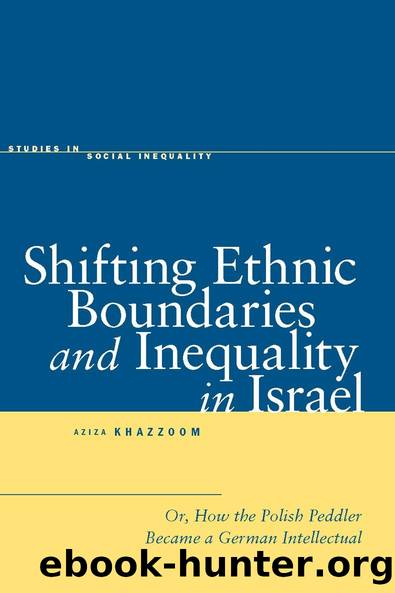Shifting Ethnic Boundaries and Inequality in Israel by Aziza Khazzoom

Author:Aziza Khazzoom [Khazzoom, Aziza]
Language: eng
Format: epub
Tags: History, Middle East, Israel & Palestine
ISBN: 9780804779579
Google: C0KvDQAAQBAJ
Publisher: Stanford University Press
Published: 2008-03-07T01:08:13+00:00
CHAPTER EIGHT
Residential Segregation and Economic Isolation: The Moroccan Paradox
In a recent Israeli movie named Go to the End of the World and Turn Left, two families have been unceremoniously dumped into an isolated Israeli settlement deep in the southern desert. One family is Moroccan but speaks French at home, another is Indian but speaks English at home. These two families must mingle with the more numerous âBerberâ Jews, who exemplify the eastern stereotypes from Chapter 6 in everything from their inability to control bodily functions to their crass manners, dress, and posture, to the religious head coverings of some older women. In fact, they are so lacking in decorum that when they join the Anglophileâs cricket team and play against visiting British diplomats, they cause the game to degenerate into a disorganized brawl. That brawl, and the embarrassment of the Europhile Mizrahim in front of non-Jewish European onlookers, are reminiscent of Segevâs (1986) description of the first Independence Day parade (Chapter 6), in which I argued that Ashkenazi Jews mourned their inability to uphold western ideals.
But in the main, the movie chronicles the sense of isolation, betrayal, and depression of the Europeanized immigrants, as they cope with their Oriental neighbors, their marginalization from Israeli urban centers and cultures (Tel Aviv, says the Francophile Moroccan mother, is Israelâs Paris), and with the downward occupational mobility caused by their placement in the desert town. By the end of the film, there is evidence of accommodation and even dichotomization. The daughter of the Francophile family questions her motherâs edict that she set herself apart from the Berbers and wonders if her mother has not exaggerated the number of family members who attended the French Sorbonne. As the daughter begins to get friendly with a Berber suitor and finds that she must stay in the town rather than join the army, one gets the sense that distinctions between Europeanized and non-Europeanized Mizrahim will, through residence in the town, attenuate. This lessening of differences between different Mizrahim is a basic dynamic of dichotomization.
The movie was set in one of Israelâs development towns, new settlements on the geographic borders of Israel that were established in order to populate the outlying areas to which most immigrants did not want to move. The movie was written by the daughter of the Francophile Moroccan protagonist and contains two claims that reflect Moroccan Jewish collective memory and recent academic research. First, it claims that Mizrahim were indiscriminately relegated to these isolated Oriental spaces. This has been a source of debate for decades, but as I noted in Chapter 5, I found strong evidence in favor of the movieâs claim in earlier work (Khazzoom 2005b).1 Second, the movie claims that relegation to these spaces resulted in downward occupational mobility. Academic research has largely agreed and has added that because Mizrahim were more likely to live in the towns, the towns themselves are one cause of occupational gaps between Mizrahim and Ashkenazim. That claim is the focus of this chapter. As I will show, the story is not simple.
Download
This site does not store any files on its server. We only index and link to content provided by other sites. Please contact the content providers to delete copyright contents if any and email us, we'll remove relevant links or contents immediately.
The European History Highway: A Guide to Internet Resources by Dennis A. Trinkle Scott A. Merriman(497)
The Seven Wonders of the Ancient World by Michael Denis Higgins(479)
European Security without the Soviet Union by Stuart Croft Phil Williams(472)
European Security in a Global Context by Thierry Tardy(471)
The Routledge companion to Christian ethics by D. Stephen Long Rebekah L. Miles(459)
Hudud Al-'Alam 'The Regions of the World' - a Persian Geography 372 A.H. (982 AD) by V. V. Minorsky & C. E. Bosworth(400)
Gorbachev And His Generals by William C. Green(392)
Get Real with Storytime by Julie Dietzel-Glair & Marianne Crandall Follis(390)
Tibetan Studies in Comparative Perspective by Chih-yu Shih Yu-Wen Chen(387)
Governance, Growth and Global Leadership by Espen Moe(384)
Hyperculture by Byung-Chul Han(379)
CliffsNotes on Fitzgerald's The Great Gatsby by Kate Maurer(360)
The Oxford History of the World by Fernández-Armesto Felipe;(354)
How Languages Are Learned 5th Edition by Patsy M Lightbown;Nina Spada; & Nina Spada(353)
The Egyptian Economy, 1952-2000 by Khalid Ikram(353)
Oral Poetry and Narratives from Central Arabia: The Poetry of Ad-Dindan : A Bedouin Bard in Southern Najd (Studies in Arabic Literature, Vol 17) (English and Arabic Edition) by P. M. Kupershoek P. Marcel Kurpershoek(345)
The Oxford Handbook of the Incas by Sonia Alconini(335)
Europe Contested by Harold James(322)
The Hutchinson Dictionary of Ancient and Medieval Warfare by Peter Connolly John Gillingham John Lazenby(307)
